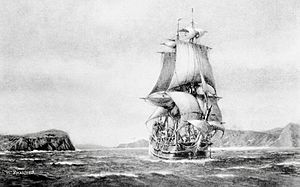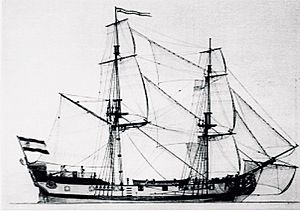San Carlos (ship) facts for kids
The San Carlos was a Spanish ship from the 1700s. It was built in 1765 in Havana, Cuba. This ship was a type of packet boat, which carried mail and passengers.
When it was first built, the San Carlos had two decks and 80 cannons. In 1775, it made history. The San Carlos was the first ship ever to sail into San Francisco Bay. This happened under the command of a Spanish naval officer named Juan Manuel de Ayala.
Later, in 1801, the ship sailed to Cartagena, Spain. There, it was changed into a bigger ship. It got a third deck and 112 cannons.

San Carlos entering the bay of San Francisco on August 5, 1775
|
|
Quick facts for kids History |
|
|---|---|
| Name | San Carlos |
| Owner | Spanish Navy |
| Builder | Royal Shipyard of Havana |
| Launched | April 30, 1765 |
| General characteristics | |
| Class and type | Packet boat |
| Tonnage | TM |
| Length | 58 ft 0 in (17.68 m) |
| Propulsion | Sail |
| Armament | 80 guns (1765), 112 guns (1801) |
Contents
Building the San Carlos
The San Carlos was built in 1765. It was made at the Royal Shipyard of Havana in Cuba. The ship was launched on April 30, 1765.
This Spanish ship was a two-masted galleon. It was about 58 feet (17.7 meters) long. It could carry 80 cannons and a crew of 30 sailors.
Journey to San Diego
During the time Spain ruled California, an important Spanish leader named José de Gálvez planned a big trip. This trip was called the Portola Expedition. It involved both land and sea travel up the Pacific coast.
The expedition was led by Gaspar de Portolá. He was the governor of Las Californias. The first part of the trip had five groups. All of them started from Baja California and went north to San Diego.
- Three groups traveled by sea.
- Two groups traveled by land with mules.
Three ships were built in San Blas, Mexico. They sailed for San Diego in early 1768. These ships were:
- The main ship, San Carlos, led by Vicente Vila.
- The San Antonio, led by Juan Pérez.
- The San José.
The ships crossed the Gulf of California. They reached the harbor of La Paz in December 1768. The San Carlos needed repairs there. It had to unload everything so it could be fixed.
On January 9, 1769, the San Carlos left La Paz. Many important people blessed the ship. These included Inspector General Gálvez and a priest named Junípero Serra.
Vicente Vila was still in charge of the ship. Other important people on board were:
- Lieutenant Pedro Fages, who later became a governor.
- Engineer Miguel Costansó, who made maps.
- 25 Catalan soldiers.
- Surgeon Pedro Prat.
- Chaplain Hernando Patron.
The San Antonio arrived in San Diego Bay on April 11, 1769. The San Carlos arrived later, on April 29. Many sailors on both ships got very sick. Most of them had scurvy. Almost everyone on the San Carlos got sick, and many died.
The ship's surgeon, Pedro Prat, tried to help the sick men. But he was also weak from scurvy. The priest, Friar Parrón, also got sick. Many sick men died in San Diego. Because so many men were lost, the San Carlos stayed in San Diego. Father Serra and Vila also remained there.
Exploring San Francisco Bay

Six years later, the San Carlos was ready for another big trip. It took on supplies and left Monterey on July 26, 1775. Its goal was to find the "Bay of San Francisco" and claim the area for Spain.
The San Carlos was the first ship to ever sail into San Francisco Bay. This happened under the command of Spanish officer Juan Manuel de Ayala. He was sent by a leader named Antonio María de Bucareli. Ayala's job was to map the waters of San Francisco Bay.
The San Carlos reached the Golden Gate entrance to San Francisco Bay on August 5, 1775.
The San Carlos dropped anchor near an island. This island was named Isla de los Ángeles, which means "Island of the Angels." Today, it is known as Angel Island. The ship's pilots used smaller boats to explore and map the bay's rivers.
On August 12, 1775, Ayala named another island La Isla de los Alcatraces. This island is now called Yerba Buena Island. The ship stayed in the Bay until September 18, 1775. Then it returned to San Blas. Ayala gave a detailed report about the geography of San Francisco Bay.
A special marker, California Historical Landmark No. 236, honors the San Carlos. It marks the spot where the first ship entered San Francisco Bay. The marker is located in the Aquatic Park Historic District. It is near the corner of Beach and Larkin Streets.
Ship's Changes
In 1801, the San Carlos sailed to Cartagena, Spain. There, it was changed into a much larger ship. It became a three-deck ship with 112 cannons. The ship was taken apart in 1819 in Cartagena.
See also
 In Spanish: San Carlos (1765) para niños
In Spanish: San Carlos (1765) para niños
- List of ships of the line of Spain
- Spanish Navy
- California Historical Landmarks in San Francisco
- Jorge Juan y Santacilia

